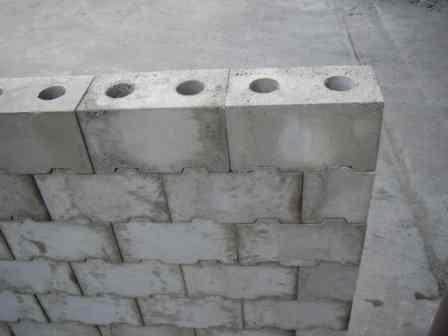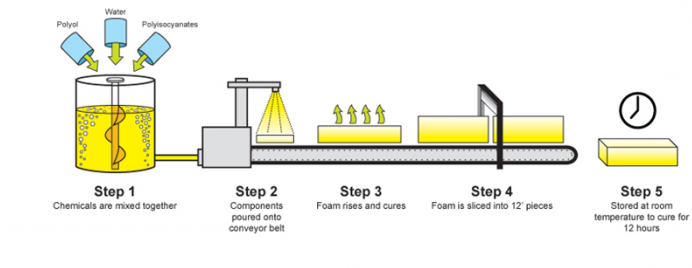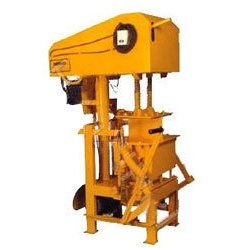Foam concrete is one of the most popular building materials. It is easy to handle, lightweight and durable at the same time. This is the main element in the construction of any buildings or structures of industrial, communal or housing.
Therefore, many specialized companies acquire special equipment for the production of foam blocks. This makes it possible to save money without overpaying to suppliers, as well as at any time to have building materials in the required quantity. But what equipment is used in the production of foam concrete? How to choose it and is it possible to make this material at home?
What is foam concrete made of?

As you know, for any high-quality building material appropriate raw materials are needed. Foam concrete is made from the following elements:
- Cement. This is the foundation of future products. Most often, ordinary Portland cement grade 400 and higher is used for these purposes. If you use other raw materials, you can get concrete of lower quality and strength. In this case, it is also necessary to observe the balance and dosage of cement. Otherwise, the product will lose its heat-insulating properties, and also significantly decrease in weight.
- Sand. Here, the quantity rather than the quality of the raw materials should be taken into account. Therefore, the required amount of sand is determined solely in relation to the brand of cement and the density of the future product. The types of work for which the material is intended are also taken into account. For example, for the D1000 brand you need 500 kg of cement and 450 kg of sand. All this is loaded into the equipment for the production of foam blocks.
- Water. Experts say that its rigidity directly affects the quality of foam concrete. Therefore, it is important to know in advance all the characteristics of the fluid used. As a rule, about 40-45 l of water is added per 100 kg of cement.
- Foaming agent and hardening accelerators. These elements, in fact, form the necessary structure of the product. They are also added in a certain proportion, based on the required brand of foam concrete.
Types of equipment for a private enterprise and their cost
Despite the fact that different technologies are used for foam concrete, the tools for each of them are quite similar. Here are a few complexes for the production of these blocks:
- Mobile installations. These are small complexes that do not include foam generators. They work according to the barotechnology method. This is a simple and inexpensive equipment. But quite a lot of foaming agent is consumed here, and the foam concrete is not so high-quality. Such devices can cost from 80,000 to 320,000 rubles. Moreover, it all depends on the number of workers involved, the weight of the structure, power and productivity.
- Specialized lines and complexes. For example, "Fomm-Prof." This complex works according to the classic foam concrete production scheme. Therefore, a rather large yield of high-quality material is obtained here. The foaming agent is consumed much less than in mobile installations. But such equipment costs an order of magnitude more than its counterparts. The price is much higher than mobile installations. On average, they cost about 1160000-1350000 rubles.
What does a standard installation consist of?

Despite the huge number of foam concrete production technologies, the general principle of creating this universal building material is quite simple. This does not require any specialized and expensive equipment. All tools can be found in almost any market of building materials and equipment.
So what does the equipment for the production of foam blocks consist of? If taken at a minimum, then the following elements must be present:
- Concrete mixer. This is a special container, welded into a metal frame for convenience. Here, with the help of a paddle rotor-activator, all the components of the foam concrete are mixed. This whole structure is powered by electricity.
- Foam generator. Here the name speaks for itself. In this device, using special blowing agents and additives, foam is generated for future blocks. The quality of the material obtained depends on the quality of this process.
- Standard forms for filling. Typically, 600 * 600 * 250 blocks are used in construction. But if necessary, you can easily choose exactly the shape and size that are needed for a particular job.
If we talk about the production of foam concrete at a more professional level, then the list of equipment used will be somewhat expanded:
- pump water dispenser;
- compressor;
- mixer;
- metal molds;
- Precise dosing and unloading station.
Also, in the modern construction market, you can pick up a ready-made complex, which includes a foam concrete mixer and a foam generator. If necessary, it can be easily modified and improved.
The process of manufacturing foam concrete. A photo

Everything is done in stages here. First, the necessary raw materials and materials are prepared. Their number is determined based on the required number of blocks and their density.
Conventionally, the whole process is divided into several stages:
- Preparation of a standard cement mortar according to known technology. The quantity and quality of raw materials depend on the specific purpose and purpose.
- Foaming. Unlike the original version, where a natural plant was used, various chemical additives are now used, as in powders.
- Mixing solution and foam. Pre-cooked items stack together.
- Pouring the resulting solution into the prepared forms.
- Solidification of the mass and obtaining the finished material.
Raw materials (water, cement and sand) are mixed in a proportion determined by the brand of future foam concrete. The volumes of material required are also taken into account. All loaded into the equipment for the production of foam blocks for several minutes.
Sometimes it takes only 20-30 seconds. Then a foam stabilizer and, in fact, the foaming agent itself are added to the mixture. Mix everything for a minimum of 2.5-3 minutes. The result should be a solution of a uniform foam with evenly distributed bubbles.
The resulting mass is poured into pre-cooked and greased forms. Here it must harden within 24 hours.
What are the best reagents to use?

The final cost of the entire production process depends not only on the prices of equipment and components. Raw materials (sand, water and cement) and various reagents should also be considered.
Typically, the following chemical components are used in the production of foam concrete:
- Frother "PB Lux". It is a yellow homogeneous liquid. This foaming agent provides a stable high-quality foam of a fairly low multiplicity. The undoubted advantages of this substance include unpretentiousness during storage, the absence of a pungent and unpleasant odor, interaction with other additives, as well as a fairly affordable price.
- "Ecopen" is a protein foam concentrate. It is a dark brown liquid. Its composition is completely environmentally friendly and non-toxic. It is stored at temperature fluctuations from -15 to + 40 ° С. In addition, after freezing, the reagent does not change its properties.
- Fiberglass. This is a special reinforcing additive. It significantly increases the resistance of foam concrete with various mechanical damage. It is added at any time during production.
- Plasticizer "Phoenix". This powdery additive significantly accelerates the set strength of foam concrete.With its use, cement consumption is reduced by almost 20%. The strength of the foam itself is increased by almost 25%.
What should I look for when buying equipment?

The production of foam concrete is now in great demand. After all, this material is used in almost all sectors of construction: housing, commercial and communal. Therefore, the issue of equipment selection should be taken quite seriously. It has its own nuances and features.
Of course, first of all, attention should be paid to the price of the production complex. Good equipment cannot cost less than 100,000 rubles. If other numbers are found in the store, then you need to think about the quality of such tools. It is better to take the equipment of a proven and already proven manufacturer than to spend free funds on endless repairs.
The next point to consider is the condition of the packing units. It is through them that the air leaves. This disadvantage affects both the loading hatch covers and the drain outlet valve.
Another common problem that equipment for the production of foam blocks at home suffers from is the quality of the joints.
How to choose a good mixer?
Now there are many technologies and complexes for the production of foam concrete. The main task is to choose the right one. One of the main structural elements is a foam concrete mixer. The quality of the final product depends on it.
 There are two types of this device: horizontal and vertical. Each of them has its own characteristics and nuances.
There are two types of this device: horizontal and vertical. Each of them has its own characteristics and nuances.
For example, a vertical foam concrete mixer loosens all the components rather than mixes them. This is due to the fact that usually below the mass is heavier and denser than above.
This may affect product quality. In addition, when using this technology, all the structural parts wear out much more than usual, especially the seal assembly under the cover itself. It is he who is the whole load when the device is running.
The horizontal mixer has no such drawbacks. Here the structure itself is made much better and more airtight, which makes it possible to use pressure up to 8 atmospheres. And the rise of the mixture is carried out at a height of 20 to 35 meters.
Equipment based on a foam generator. Advantages and disadvantages
This is one of the most common complexes used to create modern high-quality building materials. However, it also has a number of disadvantages and advantages that allow you to make the best choice when buying this type of equipment.
So, the undoubted advantages of the installation include:
- The possibility of obtaining foam with a stable density. However, its density is easy to adjust. This is achieved due to the design of the equipment and its properties.
- High performance and low foaming agent consumption. Suitable for establishing a powerful and continuous production.
- Works on any type of blowing agent. The recommended recipe is attached, but independent production of the reagent is not excluded.
- Possibility of introduction to existing concrete plants. This installation, as well as vibrating screens for the production of foam blocks, perfectly complements any equipment.
- Simplicity and reliability of the design.
At the same time, this complex is not suitable for starting production, since it requires significant financial investments.
Pros and cons of mobile equipment with a bar mixer

This complex works using pressure. This is the so-called barotechnology of foam concrete. And, of course, despite its mobility, it has a number of disadvantages:
- Low productivity due to size and low power.
- Unfixed concrete density when working with large volumes.
- Autonomy. This installation cannot be integrated into any existing production lines.
- High consumption of foaming agent and the use of better cement.
The advantages of such mobile installations include:
- Low cost. These are small, low-power installations for home production, so their price is significantly lower than standard complexes.
- Simplicity in work and service. Even untrained personnel can work with it.
- Mobility. Such equipment, despite the presence of all necessary parts, such as a compressor for the production of foam blocks, etc., weighs about 200 kg.
Features of the installation based on the porizer
This device is a design of a dynamic foam generator on the chassis and a control panel. The principle of operation is quite simple: a cement-sand mortar, together with reagents and compressed air, is supplied to the porizer. In this case, a compressor can be used for the production of foam blocks. After that, the finished material is supplied under pressure in the tank.
Advantages of this installation:
- Fairly high performance.
- Foam concrete itself can be made right at the place of its filling.
- Only with the use of this technology can ultra-light density blocks with increased strength be produced.
- Mobility and small size. This allows not to use special additional rooms for the device.
However, this complex has many additional components, which significantly increases its total cost, compared with other installations.








